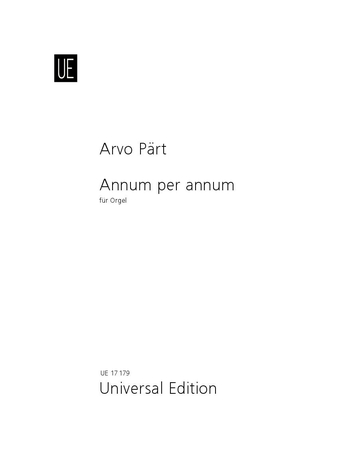Annum per annum
Description
Auftragswerk des SWF Baden-Baden, 1980. Duration: 8 minutes
After experiments with functional harmony, serialism, and polystylism, Arvo Pärt spent several years intently studying the music of the medieval and renaissance. As a result, some of his pieces demonstrate an aesthetic of all-encompassing unity and control that one could immediately associate with, if not attribute to, musical processes from centuries earlier. In the Cantus in Memory of Benjamin Britten (1977) and Festina Lente from (1988), Pärt constructs large-scale mensuration canons a la Ockeghem's Missa Prolationem; the constant parallel fourth melodic motion in Fratres recalls the early days of organum. The very title of Annum per annum (year by year) evokes the passage of large expanses time, and the perhaps the unbroken rites and traditions that string the years together.
In fact, the work--one of only a handful for organ by the composer--was commissioned in 1980 to celebrate the 900th year in which daily masses were given at the Speier Cathedral. Dedicated to St. Cecilia, the traditional patron saint of music, Annum per Annum bases its five-part structure on the ordinary of the mass: the lone letters K-G-C-S-A that mark each section correspond to the mass movements (Kyrie, Gloria, Credo, Sanctus, and Agnus Dei.). This structure is spanned by several symmetries. For example, the introduction that precedes the K is reversed in the coda that follows the A, and at the center of the piece, or more specifically, at the middle of the C section, the mode changes from D minor to D major. Each of the five sections has the same underlying structure-eight repetitions of a 13-beat phrase, and all are based on an isorhythmic and sequential cantus firmus. As the left hand and pedal execute the isorhythmic skeleton, the right hand engages in a series of melodic elaborations that continually increase in complexity before suddenly shedding all ornament and appearing in their starkest form during the A section.
The most immediately striking features of this piece's landscape are the extreme dynamic contrasts. The introduction consists of a series of repeated or sustained D's and A's spread over several octaves. They begin fortissimo, but the player is instructed to gradually close stops-and even turn off the motor that blows the pipes-until the sound disappears completely. Over the course of the five inner sections, the dynamics follow the increasingly elaborate right-hand figuration by gradually becoming louder; accordingly, when the melody turns simple in the A section, the volume drops to pianissimo. The coda, now adding a major third to the fifths that opened the work, inverts the hairpins from the introduction by beginning at a faint piano, and growing stop by stop over the course of nearly a minute into a roaring forte-fortissimo.
-- Jeremy Grimshaw
- Winkel Antwerpen : Available
